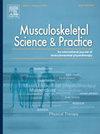有或无颈部疼痛者的头颈力稳定性和力感
IF 2.2
3区 医学
Q1 REHABILITATION
引用次数: 0
摘要
背景:颈椎疼痛患者存在本体感觉和运动控制障碍,但关于颈椎力稳定性和力感的缺陷和可靠性的数据有限。目的评价颈痛患者和非颈痛患者颈椎力稳定性和力感的组间差异及重测信度。设计横断面比较研究。方法14例慢性颈部疼痛(CNP)患者和15名年龄相当的健康参与者完成了随机等长收缩方案,包括颈椎屈曲、伸展、旋转(左和右)和侧屈(左和右),强度分别为其最大自愿收缩(MVC)的10%和25%。24名参与者在4-7天后完成了第二次测试,以评估可靠性。将力转换为变化系数(COV)来衡量力的稳定性,并将绝对误差(AE)、恒定误差(CE)和可变误差(VE)转换为力感。结果scnp参与者在10% MVC时表现出更差的总VE(平均差36.96%,p <;措施)。力感的可靠性从差到好,CE的可靠性最好(ICC估计为0.21-0.88)。10% MVC的CNP人群的力稳定性显著差(平均差42.26%,p <;.001)和25% MVC(平均差异23.97%,p <;.001),除两次收缩外,所有收缩的可靠性均为中等-良好(ICC估计为0.53-0.87)。结论CNP患者在力稳定性和力感方面表现出损伤,尤其是在10%的MVC强度收缩时。力感的可靠性各不相同,大多数收缩对力稳定的可靠性表现为中等-良好。本文章由计算机程序翻译,如有差异,请以英文原文为准。
Cervicocephalic force steadiness and force sense in people with and without neck pain
Background
Proprioceptive and motor control impairments have been identified in people with neck pain, but there is limited data regarding deficits and reliability of cervical force steadiness and force sense.
Objectives
To evaluate between-group differences and test-retest reliability of cervical force steadiness and force sense in people with and without neck pain.
Design
Cross-sectional comparative study.
Method
Fourteen people with chronic neck pain (CNP) and 15 healthy participants of comparable age range completed a force-matching protocol of randomised isometric contractions for cervical flexion, extension, rotation (left and right), and lateral flexion (left and right) at intensities of 10% and 25% of their maximal voluntary contraction (MVC). Twenty-four participants completed a second session 4–7 days later to evaluate reliability. Force was converted to coefficient of variation (COV) to measure force steadiness, and absolute error (AE), constant error (CE), and variable error (VE) for force sense.
Results
CNP participants demonstrated worse total VE at 10% MVC (mean difference 36.96%, p < .001). Reliability of force sense varied between poor to good, with best reliability shown for CE (ICC estimates 0.21–0.88). Force steadiness was significantly worse in the CNP population for 10% MVC (mean difference 42.26%, p < .001) and 25% MVC (mean difference 23.97%, p < .001), and reliability was moderate-good for all contractions (ICC estimates 0.53–0.87) except two.
Conclusions
People with CNP demonstrated impairments in force steadiness and force sense, particularly at 10% MVC intensity contractions. Reliability was varied for force sense and most contractions demonstrated moderate-good reliability for force steadiness.
求助全文
通过发布文献求助,成功后即可免费获取论文全文。
去求助
来源期刊

Musculoskeletal Science and Practice
Health Professions-Physical Therapy, Sports Therapy and Rehabilitation
CiteScore
4.10
自引率
8.70%
发文量
152
审稿时长
48 days
期刊介绍:
Musculoskeletal Science & Practice, international journal of musculoskeletal physiotherapy, is a peer-reviewed international journal (previously Manual Therapy), publishing high quality original research, review and Masterclass articles that contribute to improving the clinical understanding of appropriate care processes for musculoskeletal disorders. The journal publishes articles that influence or add to the body of evidence on diagnostic and therapeutic processes, patient centered care, guidelines for musculoskeletal therapeutics and theoretical models that support developments in assessment, diagnosis, clinical reasoning and interventions.
 求助内容:
求助内容: 应助结果提醒方式:
应助结果提醒方式:


